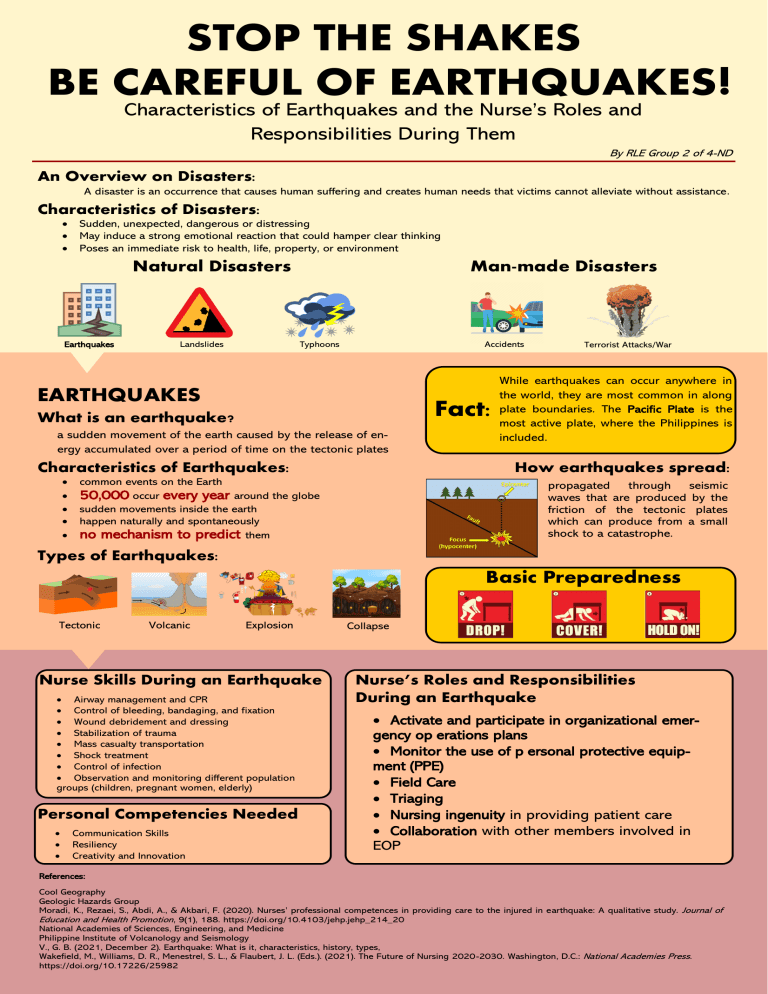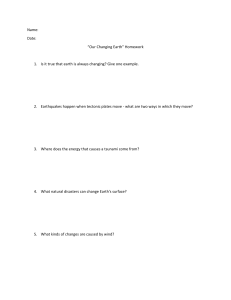
STOP THE SHAKES BE CAREFUL OF EARTHQUAKES! Characteristics of Earthquakes and the Nurse’s Roles and Responsibilities During Them By RLE Group 2 of 4-ND An Overview on Disasters: A disaster is an occurrence that causes human suffering and creates human needs that victims cannot alleviate without assistance. Characteristics of Disasters: • • • Sudden, unexpected, dangerous or distressing May induce a strong emotional reaction that could hamper clear thinking Poses an immediate risk to health, life, property, or environment Natural Disasters Earthquakes Landslides Man-made Disasters Typhoons Accidents EARTHQUAKES Fact: What is an earthquake? a sudden movement of the earth caused by the release of energy accumulated over a period of time on the tectonic plates Characteristics of Earthquakes: • • • • • Terrorist Attacks/War While earthquakes can occur anywhere in the world, they are most common in along plate boundaries. The Pacific Plate is the most active plate, where the Philippines is included. How earthquakes spread: common events on the Earth 50,000 occur every year around the globe sudden movements inside the earth happen naturally and spontaneously no mechanism to predict them propagated through seismic waves that are produced by the friction of the tectonic plates which can produce from a small shock to a catastrophe. Types of Earthquakes: Basic Preparedness Tectonic Volcanic Explosion Nurse Skills During an Earthquake • Airway management and CPR • Control of bleeding, bandaging, and fixation • Wound debridement and dressing • Stabilization of trauma • Mass casualty transportation • Shock treatment • Control of infection • Observation and monitoring different population groups (children, pregnant women, elderly) Personal Competencies Needed • • • Communication Skills Resiliency Creativity and Innovation Collapse Nurse’s Roles and Responsibilities During an Earthquake • Activate and participate in organizational emergency op erations plans • Monitor the use of p ersonal protective equipment (PPE) • Field Care • Triaging • Nursing ingenuity in providing patient care • Collaboration with other members involved in EOP References: Cool Geography Geologic Hazards Group Moradi, K., Rezaei, S., Abdi, A., & Akbari, F. (2020). Nurses’ professional competences in providing care to the injured in earthquake: A qualitative study. Journal of Education and Health Promotion, 9(1), 188. https://doi.org/10.4103/jehp.jehp_214_20 National Academies of Sciences, Engineering, and Medicine Philippine Institute of Volcanology and Seismology V., G. B. (2021, December 2). Earthquake: What is it, characteristics, history, types, Wakefield, M., Williams, D. R., Menestrel, S. L., & Flaubert, J. L. (Eds.). (2021). The Future of Nursing 2020-2030. Washington, D.C.: National Academies Press. https://doi.org/10.17226/25982




